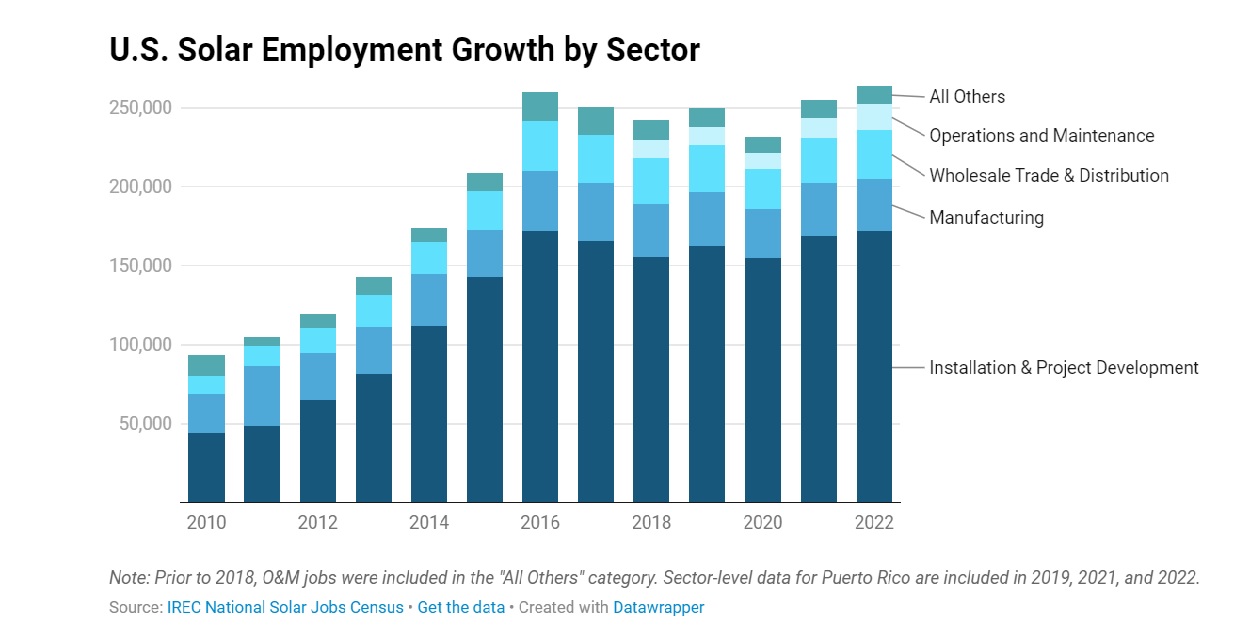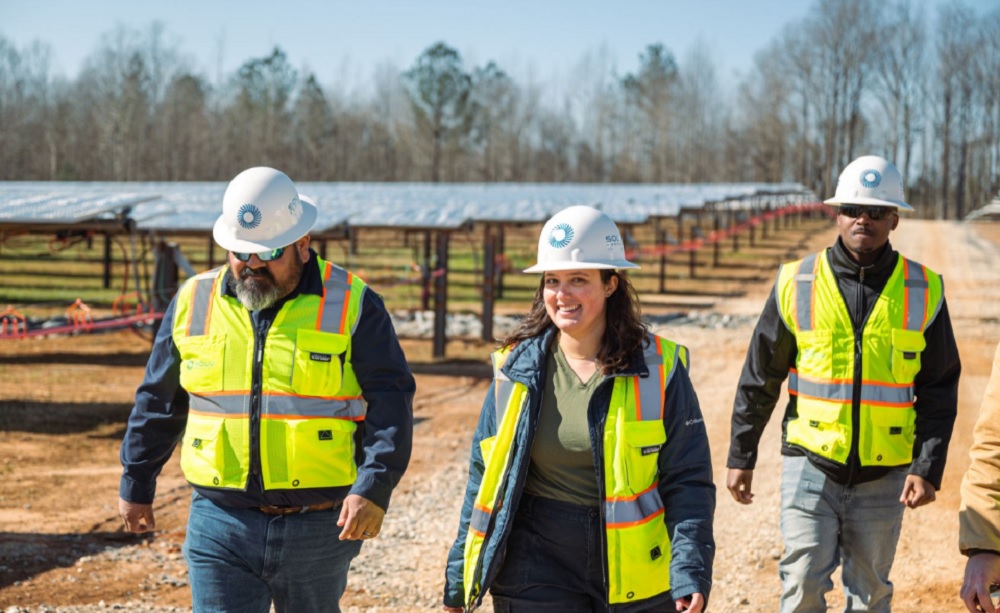According to the 13th annual National Solar Jobs Census released by the Interstate Renewable Energy Council (IREC), full-time jobs in the U.S. solar energy and energy storage industries grew in 2022 and demand will only increase in the future.
The new report finds that the solar energy workforce grew by 3.5% in 2022, with a total of 263,883 solar workers in all 50 states, the District of Columbia, and Puerto Rico, an increase of 8,846 jobs since 2021. Energy storage jobs grew 4.6% over 2021.
“The solar industry has grown by leaps and bounds over the past decade, overcoming one challenge after the next to provide a quarter million jobs for Americans of all educational levels and backgrounds,” said Larry Sherwood, president and CEO at IREC. “With the passage of the Inflation Reduction Act, we can look forward to transformational jobs growth in solar, batteries, and other clean energy industries in the years ahead.”
About two-thirds of the U.S. solar jobs are at installation and project development firms. The strongest growth sector was the residential market, which grew 11% or by about 9,500 jobs. The utility-scale market contracted by about 6,000 jobs in 2022, which was a challenging year due to the threat of solar tariffs and supply chain concerns.
About 33,400 jobs were in manufacturing associated with solar, and that sector is expected to grow as manufacturers of modules, cells and wafers open factories in the U.S. to take advantage of the production tax credits in the Inflation Reduction Act (IRA).

California leads the way with a total of 2,404 solar jobs added in 2022, followed by New York (988 jobs), Texas (904 jobs), Florida (506 jobs) and Massachusetts (476 jobs). The top state for energy storage jobs was also California, with a total of 17,580. An interactive state map of jobs in solar and other clean energy industries is available here.
Diversity challenge
In October 2021, Solar Energy Industries Association (SEIA) launched its Diversity, Equity, Inclusion and Justice (DEIJ) Certification Program, which encourages broad participation across the clean energy industries and rewards companies working to create a more inclusive work environment, serve their communities, and attract, hire, promote, and retain diverse talent. SEIA reported good progress in the diversity program, with 45 companies enrolled in its first year.
The IREC report found that the number of women in solar has been on the rise for sometime, showing that women made up 27% of the workforce in 2017 and that has risen to 31% in 2022. The report noted that Black people made up 9% of the workforce, compared to 13% in the overall workforce. Veteran representation in solar is 8%, compared to just 5% in the overall workforce. And the solar workforce is relatively young, with only 13% over 55, compared to 24% nationwide.
Looking at demographics within the various sectors of the solar industry, women make up 30% of the installation and project development sector; however, women make up on 11% of the construction sector. the proportion is 11%. The solar manufacturing sector has about the same percentage of women employees as the overall U.S. manufacturing sector. Black workers make up 9% of the solar manufacturing sector compared to 11% of overall U.S. manufacturing.
“Solar energy projects provide opportunities for professionals with a diverse array of skills and create well-paying jobs in the communities where we build and operate,” said George Hershman, CEO of SOLV Energy. “What’s more, demand for solar has a ripple effect that creates jobs in other industries that provide critical equipment, fencing and even lunch for our workers, creating returns for local businesses that allow them to hire more workers.”
Finding workers
While providing good paying jobs and appealing to a diversity of workers are noble pursuits, the reality is that the tight labor market in the U.S. continues to create hiring challenges. The report notes that in 2022, 44% of solar industry employers said it was “very difficult” to find qualified applicants—the highest such percentage ever recorded in the Solar Jobs Census.
New workforce-related requirements were put into place by the Inflation Reduction Act (IRA) that aims to address training, pay, diversity and job development in underserved areas.
To meet new apprenticeship requirements, taxpayers must ensure that, for construction that begins before January 1, 2023, at least 10% of labor is performed by qualified apprentices. This steps up to 12.5% for construction that begins after December 31, 2022, and before January 1, 2024. And then bumps up again to 15% for construction that begins after December 31, 2023. In response to the requirements, apprenticeship programs, especially at community colleges, are popping up across the country, rising up to meet the projected need for workers.
The IREC report found that most new hires in 2022 required some previous work experience. Less than half of all new hires required a bachelor’s degree, about a third required an associate’s degree, and almost none required a vocational or post-secondary certificate.
“In 2022, the U.S. solar industry remained resilient and kept more than 263,000 Americans on the payroll,” said Abigail Ross Hopper, president and CEO of the SEIA. “More than half of all new solar jobs in 2022 did not require a bachelor’s degree, helping even more Americans launch their career in a forward-thinking and mission-driven industry. We’ve also made considerable progress welcoming more women and people of color to the solar industry, but we must continue to create inclusive and intentional workforce development strategies that can deliver our clean energy future.”
Future
Respondents to the Solar Jobs Census survey indicated that they expect a 9% growth in employees, which would bring the total to 287,632 solar workers. Assuming that supply chain concerns are alleviated and installations ramp up as expected, 2023 could be a year of growth; however, IREC expects the real growth to come next year and beyond.
IREC notes that the solar industry expects total U.S. installations will multiply fivefold in the next 10 years, from 141 GW in 2022 to over 700 GW in 2033. SEIA optimistically predicts the total number of solar jobs could more than double, reaching 538,000 by 2032.
This content is protected by copyright and may not be reused. If you want to cooperate with us and would like to reuse some of our content, please contact: editors@pv-magazine.com.









By submitting this form you agree to pv magazine using your data for the purposes of publishing your comment.
Your personal data will only be disclosed or otherwise transmitted to third parties for the purposes of spam filtering or if this is necessary for technical maintenance of the website. Any other transfer to third parties will not take place unless this is justified on the basis of applicable data protection regulations or if pv magazine is legally obliged to do so.
You may revoke this consent at any time with effect for the future, in which case your personal data will be deleted immediately. Otherwise, your data will be deleted if pv magazine has processed your request or the purpose of data storage is fulfilled.
Further information on data privacy can be found in our Data Protection Policy.